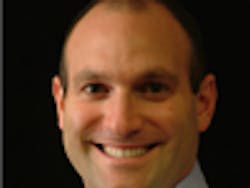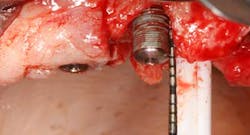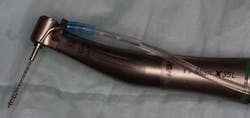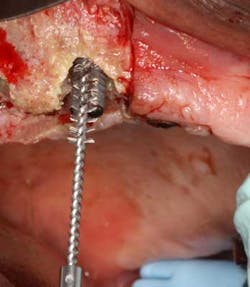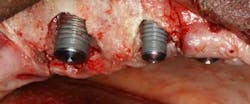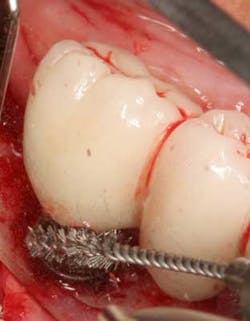A new tool in the fight against peri-implant disease
Peri-implant disease has been defined as an inflammatory process affecting the hard and/or soft tissues surrounding an implant in function. (1) Peri-implant diseases can be broken down further into two entities: peri-implant mucositis and peri-implantitis. Peri-implant mucositis has been described as a disease in which the presence of inflammation is confined to the soft tissues surrounding a dental implant with no loss of supporting bone following initial bone remodeling. Peri-implantitis on the other hand has been characterized by an inflammatory process around an implant, which includes both soft tissue inflammation and progressive loss of supporting bone beyond biological bone remodeling. Peri-implant mucositis has been compared to gingivitis around natural teeth, whereas peri-implantitis has been compared to periodontitis. In addition, both the inflammatory process and the gram-negative biofilm associated with tissue breakdown around teeth are similar to that of implants. (2)
RELATED |I'll have a maxillary anterior implant to go; please hold the periodontal treatment
Various treatment methods have been suggested in the literature. Nonsurgical mechanical debridement using various types of hand curettes, cavitrons, and piezoelectric devices with or without the use of local or systemic antibiotic have been shown in the literature to have success in reducing inflammation associated with peri-implant mucositis. (3) Furthermore the addition of lasers to these treatments has been shown to have additional benefits of reduction in inflammation and improvement in tissue tone. For more pronounced and challenging lesions associated with peri-implantitis, access flaps combined with antimicrobial therapy with or without regenerative therapy has been shown to have superior results compared with nonsurgical treatment. (4)
Whatever treatment modality is chosen, the most important determinant to success of therapy is the complete debridement of the lesion. (5) The bacterial assault that has infiltrated peri-implant tissue as well as the implant surface needs to be thoroughly removed if any treatment is expected to work. Complete access to infected areas as well as proper instrumentation is needed in order to remove the bacterial challenge. Unfortunately, many of the bony lesions seen around implants affected by peri-implantitis as well as the implant surfaces themselves are hard to access and debride. (Fig. 1) A new titanium brush has recently been released on the market to aid in the process of implant surface decontamination. This brush is composed of titanium bristles with a stainless steel shaft (Fig. 2) that is inserted into your oscillating-rotating implant machine handpiece.
References
1. Albrektsson T, Isidor F. Consensus report of session IV. In: Lang NP, Karring T (eds). Proceedings of the First European Workshopon Periodontology. London: Quintessence, 1994;365–369.
2. Leonhardt A°, Berglundh T, Ericsson I, Dahle´n G. Putative periodontal pathogens on titanium implants and teeth in experimental gingivitis and periodontitis in beagle dogs. Clin Oral Implants Res. 1992;3:112-119.
3. Salvi GE, Aglietta M, Eick S, Sculean A, Lang NP,Ramseier CA. Reversibility of experimental peri-implant mucositis compared with experimental gingivitis in humans. Clin Oral Implants Res. 2012;23:182-190.
4. Serino G, Turri A. Outcome of surgical treatment of peri-implantitis: Results from a 2-year prospective clinical study in humans. Clin Oral Implants Res. 2011;22:1214-1220.
5. Froum SJ, Rosen PS. A proposed classification for periimplantitis. Int J Periodontics Restorative Dent. 2012;32:533-540.
